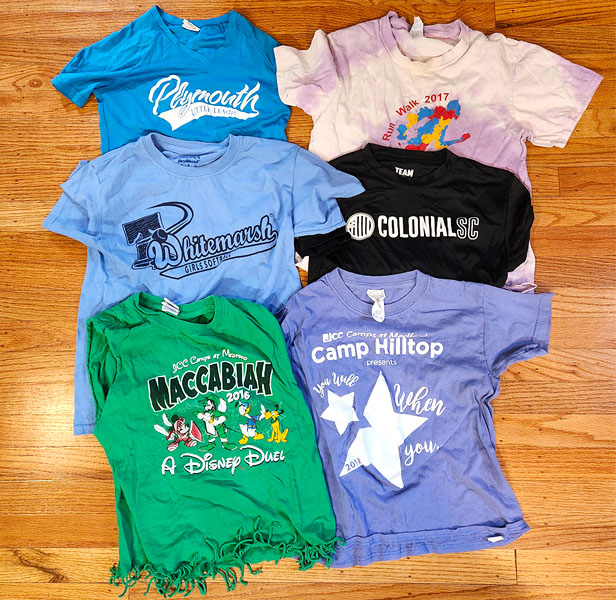Sustainability February 14, 2023
I Don’t Want To Throw Away These Logoed T-Shirts
It’s not obvious to me and millions of other people how to recycle clothing. We need to change that.
Drawers flung open. Bags and shoes piled on the floor. Shirts and hangers scattered anywhere and everywhere.
Welcome to the war zone known as my children’s closet.
In our family’s time-honored ritual, this chaotic scene persists for days until my wife and I bellow at our kids (OK, not so much “we” as my wife) to clean it up. As regular as the changing of the seasons, my wife’s frustration boils over and she removes all the old clothes that my kids have grown out of or refuse to wear.
And that brings me to this moment – staring at a pile of logoed shirts. There are camp tees and fun run shirts and sports jerseys from multiple seasons of me futilely trying to coerce 5- and 6-year-olds to catch a ball.

A sampling of old logoed shirts from sports leagues and summer camps that my kids have grown out of.
What do you do with a pile of old clothes? It’s a common dilemma with a discouraging solution. According to the EPA, roughly 85% of textiles aren’t recycled. The vast majority end up in the trash.
I don’t want to be part of that statistic. I want to do better. I just don’t know how. And neither do millions of other people.
Certain things I hate to throw away. That doesn’t make me a hoarder. And it doesn’t mean I’m patching old clothes or gluing together broken dishes.
It does mean that I’m not going to trash something that still has value. For example, instead of tossing a piece of furniture, I post it for free on Craigslist or our local Buy Nothing group to find it a good home. It gives me pleasure, even if it’s a little extra work.
And so, when we have old clothes, I normally run them over to the nearest GreenDrop truck for donation.
Promotional products – and specifically logoed apparel – are a different story. Many charities won’t accept clothing with logos. Even if branded apparel has the powerful ability to turn people into walking billboards, someone who isn’t the intended recipient won’t always wear a shirt or hat with an organization they’ve never heard of.
Still, I try my local charities. When I call GreenDrop to ask if they take logoed shirts, a representative tells me, “No, we don’t, unfortunately. We can’t take anything that has corporation logos or any kind of logo on it.”
85%
The percentage of textiles that aren’t recycled.[United States Environmental Protection Agency]
Cradles to Crayons, a fantastic children’s charity that our family often supports (it has locations in Philadelphia and three other major U.S. cities) says the same thing. “We accept logos with sports teams like the Eagles,” an employee tells me over the phone, “but we don’t accept clothing with logos for smaller things like little leagues or fun races.”
To be clear, not every organization has this policy. Goodwill says it would take the shirts and offer them for sale if they’re in good condition. Donated items of all kinds that aren’t sold, according to its website, are eventually recycled. But I still have my reservations. While I can easily see some promo items (such as concert T-shirts) having resale value, who wants to buy my kids’ soccer shirts?
I need to dig deeper. So, I do what any good journalist or businessperson would do – I talk to people who know a lot more than me.
“The concept for our program Re-Spun came about in a similar fashion to what you experienced,” says Andrew Graham. Graham is the senior director for wholesale and custom at Marine Layer (asi/68730), a retail clothing brand that entered the promo space a few years ago.
By the nature of its business, the San Francisco-based supplier makes a lot of clothes, but still wanted to make a positive impact – from manufacturing long-lasting, quality garments to considering what the end-of-life fate would be for its wares. “One of the things that we realized as we continued to grow our business,” Graham says, “was that there only seemed to be options to donate clothes, and not a ton to recycle.”
So, the company launched its Re-Spun program in 2019. Any T-shirt can be returned to mailboxes in one of the company’s retail stores, or shipped in a prepaid mailer after notifying the company. In return, consumers and end-buyers receive credit toward future Marine Layer purchases. The cotton-rich tees (at least 80% of the fabric) will be made into new Marine Layer shirts; the rest are downcycled into other things like carpet padding or stuffing for stuffed animals.
View this post on Instagram
Graham admits they’ve learned a few things along the way (sorting garments and removing labels to prepare them for recycling was a major time sink, for example), but overall the program has been successful, with the company having collected over 500,000 shirts. “We can do it at a much larger scale than we were able to do it before,” he says, “allowing us to create the circularity where we can take back old shirts.”
“Is the message you want to put out ‘Hey, any T-shirts you have, we’ll take ’em?” I ask Graham near the end of our conversation.
He hesitates for a couple of beats. “Kind of,” he responds. “In a perfect world, that’s what I would want it to be. But at the end of the day, we’re not a recycling company.” Advancing the Re-Spun program is possible because Marine Layer continues to thrive as an apparel company. If the recycling process becomes so expensive and onerous that it dwarfs the profits of selling clothing, then Marine Layer would be out of business, and the Re-Spun program wouldn’t exist.
Over in Somerville, MA, Ben Grossman and Grossman Marketing Group (asi/215205) started SwagCycle to keep unused and no longer needed promotional products out of landfills. When companies contact SwagCycle to help with their old merch, Grossman says his team asks whether the items can go to charity or if the items, per brand guidelines and desire, need to leave the marketplace. “We find that the items that companies are most sensitive about are apparel items,” says the Grossman Marketing Group co-president. Companies are understandably loath for their old uniforms and branded garments to end up in unintended places. It creates the opportunity for people to impersonate company employees, for example. They also worry about someone performing a criminal act or getting arrested while wearing the apparel. Because of those concerns, and the fact that apparel makes up over 40% of industry spend, says Grossman, “it’s overwhelmingly the most requested item to recycle.”
With apparel, SwagCycle calls on its network of recycling partners who transform the garments into industrial wiping clothes, carpet pad fill, insulation material and other things. It depends on how broken down the client wants the material and the fee they’re willing to pay for those extra steps.
By the end of 2022, SwagCycle has kept 1.45 million items out of landfills and facilitated $2.7 million total in charitable donations. The SwagCycle model is working, and Grossman, who last year was named the Bess Cohn Humanitarian of the Year by Counselor, notes “we’ve tried to make the process as easy as possible for the company that has the goods” to donate or recycle them.
Throwing away clothing is so easy. How can we make clothing donations and recycling equally easy? “In order to increase charitable donation rates and recycling rates of clothing, it needs to be a convenient and relatively frictionless process,” Grossman says. He ticks off a few ideas: local collection bins, charitable drives, low-cost ways to ship goods to nonprofits and recycling partners.
Graham echoes the sentiment. “In order for it to make a really meaningful impact,” he says, “it has to be widespread. It has to be everywhere.”
Which means that it must be more than only Marine Layer, SwagCycle and a few other entities chipping away at a massive problem. It has to be broad and visible, coordinated by businesses, nonprofits and even government so that there’s no question about where old clothing can go to be recycled or to have a second (and third) life. In fact, the state of Massachusetts has banned the disposal of textiles since November, and the City of Boston along with dozens of other state municipalities have policies in place for curbside pickup and drop boxes.
5.8%
The percentage that textiles made up of all the trash in the U.S. in 2018.[United States Environmental Protection Agency]
Recycling is now deeply embedded in our lives. In the U.S., the recycling rate in 1960 was less than 7%. Today, it’s 32%. We have blue bins on every corner and curbside pickup at our house. Ideally, textile recycling will become just as inescapable. And knowing what to do with an old T-shirt will become as obvious recycling a soda can.
In my conversation with Grossman, he alerts me to a company called Helpsy, which on its website describes itself as a “for-profit B Corp with an environmental mission to radically change the way people think about clothing recycling.” The company says it collected over 29 million pounds of clothes in the Northeast U.S. last year. It sorts the clothing to sell to thrift stores and secondhand markets or to be recycled.
I go to the Helpsy website and click on “Find a Bin” to see the nearest drop-off location. There on the digital map, it shows a bin exactly 1 mile from my house.
There’s a surprise ending to this story. As I was researching this topic, talking to industry folks and plotting how to recycle promotional apparel, my wife saw a post on Facebook from a friend looking for old clothes for an upcycle project. She gave them to her friend; they never made it to the donation or recycling bin.
In hindsight, I didn’t have to embark on this journey. The problem took care of itself. But now I understand that no piece of clothing ever has to be thrown away. I know what to do. And I hope someday, the rest of the world will too.

Promo for the Planet is your destination for the latest news, biggest trends and best ideas to help build a more sustainable and socially-responsible industry.
